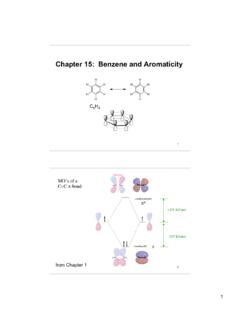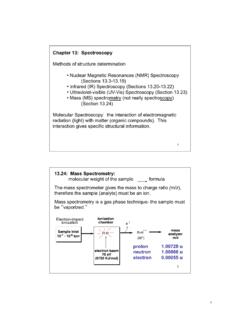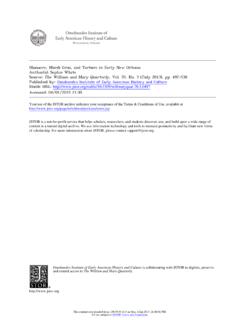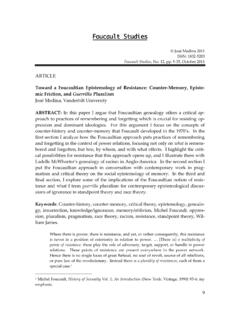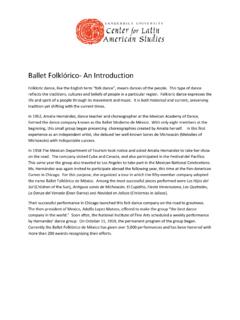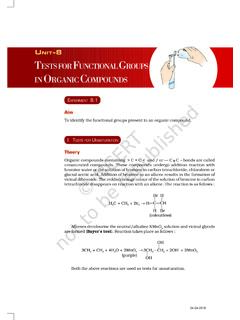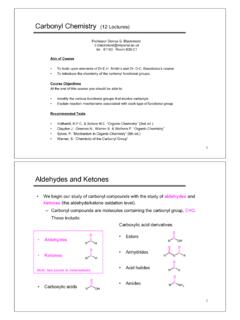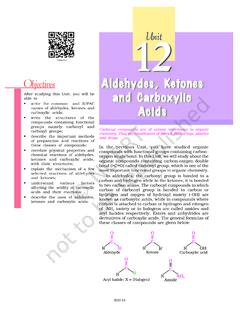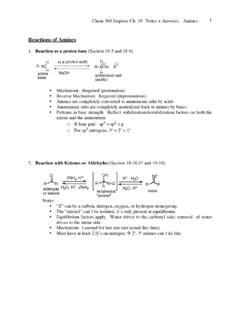Transcription of Chapter 23. Carbonyl Condensation Reactions
1 130256 Chapter 23. Carbonyl Condensation ReactionsAs a result of the large dipole of the Carbonyl group:1. The Carbonyl carbon is electrophilic and is the siteof addition Reactions by nucleophiles;2. The -protons are acidic and can be deprotonatedby strong bases to give an enolate, which arenucleophiles and react with anion(nucleophile)CCOECCEONu:CONuCOHNuCO H3O+ ketone /aldehyde(electrophile) Chapter s 19 & 20 Chapter Mechanism of Carbonyl Condensation Reactions An enolate of one Carbonyl (nucleophile) reacts with the Carbonyl carbon (electrophile) of a second Carbonyl compound (1,2-addition reaction) resulting in the formationof a new C-C bondGeneral mechanism (Fig. , page 855): Nucleophilic Carbonyl : aldehydes , ketones, esters, amides andnitrileElectrophilic Carbonyl : aldehydes , ketones, , -unsaturated ketones, and Condensations of aldehydes and Ketones: The Aldol ReactionThe base-catalyzed self-condesnation reaction of acetaldehyde gives 3-hydroxybutanal (aldol)General mechanism of the aldol reaction (Fig.)
2 , page 857)H3 CCHO acetaldehyde2 NaOEtEtOHCH2 CHOCHH3 COH3-hydroxybutanal(!-hydroxy aldehyde)The base-catalyzed aldol reaction (NaOEt, EtOH) is reversible 259 The position of the equilibrium for the aldol reaction is highly dependent on the reaction conditions, substrates, and steric considerations of the aldol Reactions involving -monosubstituted aldehydesare generally favorablealdol Reactions involving , -disubstituted aldehydesare generally unfavorablealdol Reactions involvingketones are generally Carbonyl Condensation Reactions versus Alpha-Substitution ReactionsO+ RCH2 XOCH2 ROHOHow do you suppress Carbonyl Condensation during an -alkylation reaction??OLDA, THF, -78 COLiRCH2 XOCH2 RThe enolate is discretely and quantitatively generated withLDA at low temperature, then the alkyl halide is addedto the solution of the enolate. Dehydration of Aldol Products: Synthesis of EnonesThe -hydroxy Carbonyl product of the aldol reaction canundergo dehydration to yield a conjugated enones; thisstep is irreversible and is catalyzed by either acid (p.
3 859)133262 The aldol reaction can be driven toward products by dehydrationCCRONaOEtEtOHRHHRCCOHRCCRHHRH ORCCORCCRHHR- H2 OThe -orbitals of the C=C and C=O are in conjugation, which isa stabilizing influence of , -unsaturated carbonylsOOHO22%NaOHEtOHOOHO92%NaOHEtOHD O CCCO263 Synthesis of , -unsaturated Carbonyl compoundsRCNRClCOMgBrthen H3O+CuLi2RO , -unsaturated ketonesROBr2, AcOHROBr(H3C)3CO- K+ROHOOBr2, PBr3then H2O, orROH, or R2 NHYOR(H3C)3CO- K+YO , -unsaturated ketones and aldehydes , -unsaturated acids, esters and amidesCCR2 ONaOEt, EtOHR1 HHR2 CCOR1 CCR1 HHR2- H2O , -unsaturated ketones, aldehydes and Mixed Aldol ReactionsAldol reaction between two different Carbonyl compoundsCOHCH3 CHHCOHCH3CH2CH2 CHH+EtONa,EtOHCOHCCH3 CHH3CH2CH2CH2 CHHOC5C3 COHCCH3CH2CH2 CHH3CH2 CHHOCOHCCH3 CHH3CH2 CHHOCOHCCH3CH2CH2 CHH3CH2CH2CH2 CHHOFour possible productsAldehydes with no -protons can only act as the electrophileCOHCH3CH2CH2 CHHCOHCH3CH3 CCH3 COHCCH3CH2CH2CH(H3C)3 CHHOEtONa,EtOHCOH+EtONa,EtOHCOHCH3 CHHCOHCCH3 CHHHO+265 COHCH3CH2CH2 CHHCOOEtCCHHH3CO+EtONa,EtOHCCCH3CH2CH2 CHHHCO2 EtCH3 OOne of the Carbonyl compounds is significantly more acidicDiscrete (in situ)
4 Generation of an enolate with LDACOHCH3CH2CH2 CHHLDA, THF, -78 CCOHCH3CH2CH2 CHLi+COHCH3 CHHCOHCCH3CH2CH2 CHH3CH2 CHHO then H2 OCOHCH3 CHHLDA, THF, -78 CCOHCH3 CHLi+COHCH3CH2CH2 CHHthen Intramolecular Aldol ReactionsTreatment of a dicarbonyls compound can lead to an intramolecular aldol Condensation . Formation of five-and six-membered rings are favorable. OOEtONa, EtOHOOEtOHOHOO- H2 OOOEtONa, EtOHOOEtOHOOH- H2OO267 More favorable ring sizes (less strained) are made from intramolecular reactionsO- H2 OOOOOOOH- H2 OOOOOOOOOHOOHOH- H2 OOOOOHOHO- H2 Oless favoredpathwayless favoredpathway136268 CyclononaneCyclodecaneCyclopentadecaneAl kane referenceCycloalkaneRing Size (n)34567891015!HcombKJ/mol20902744322039 5246375310598166369985!Hcombper -CH2-KJ/mol69868666465966266466566465965 9 Total Strain Energy1151102702742545000 Figure (page 111) Strained ringsCommonringsMediumrings< 12 Large Using Aldol Reactions in SynthesisVery important C-C bond forming reaction.
5 Readily makelarge carbon skeletons from smaller onesR1 OHOHR1R1 OHR1aldol products-or-R1 OHOR1H+aldol reactionR1 OHR1H2, Pd/C-or- !-alkylationR1 OHR1X+Robert B. Woodward (Harvard): 1965 Nobel Prize in Chemistry"for his outstanding achievements in the art of organic synthesis"WittigreactionR1R1R2R1 OHR2R1 Grignardaddition137270OH2-ethyl-1-hexano lOHtwo n-C4 unitsHOHOHOHOHOX271 Problem : Which of the following are aldol Condensation products?a. 2-hydroxy-2-methylpentanalb. 5-ethyl-4-methyl-4-hepten-3-oneCHOCH3 HOOP roblem : Which of the following can probably be prepared by a mixed aldol reaction? a. b. c. The Claisen Condensation ReactionBase catalyzed Condensation of two esters to givea -keto-ester productH3 CCOEtOEthyl acetate2 NaOEt EtOHthen H3O+CH2 COEtOCHH3 COEthyl 3-oxobutanoate(Ethyl acetoacetate)Mechanism: has features of the aldol and nucleophilic acyl substitution Reactions (Fig.)
6 , page 866)273 The product -keto ester product of the Claisen Condensation is more acidic than the reactants; deprotonation of the product drives the reaction forward. One full equivalent of base must be used in the Claisen Condensation . Claisen CondensationStrategies are similar to that of the mixed aldol +EtONa,EtOHCOOEtCCH3 CHH3CH2CH2CH2 COC5C3 COOEtCCH3CH2CH2 CHH3CH2 COCOOEtCCH3 CHH3CH2 COCOOEtCCH3CH2CH2 CHH3CH2CH2CH2 COthen H3O+Four possible productsEsters with no -protons can only act as the electrophileCOOEt+EtONa,EtOHCOOEtCH3 CHHCOOEtCCH3 CHOthen H3O+139274 Discrete (in situ) generation of an ester enolate with LDAM ixed Claisen condensations with a ketone enolate and esters OCOOEtH3CH2 CEtONa,EtOHthen H3O++OOCH2CH3 COOEtHOOHO+EtONa,EtOHthen H3O+COOEtEtOOOOEtO+EtONa,EtOHthen H3O+COOEtCH3CH2CH2 CHHLDA, THF, -78 CCOOEtCH3CH2CH2 CHLi+COOEtCH3 CHHCOOEtCCH3CH2CH2 CHH3CH2 COthen H2O+COOEtCH3 CHHLDA, THF, -78 CCOOEtCH3 CHLi+COOEtCH3CH2CH2 CHHthen H3O+ Intramolecular Claisen Condensations: The Dieckmann CyclizationDieckmann cyclization is an intramolecular Claisen : same as the Claisen (Fig.
7 , page 879)140276 Dieckmann Cyclization works best with 1,6-diesters, to give a 5-membered cyclic -keto ester product, and 1,7-diesters to give 6-membered cyclic -keto ester , EtOHOEtOOOEtOEtOCO2 EtCO2 EtOOEtOOEtOOEtOOOEtEtONa, EtOHOEtOCO2Et- EtO- EtOCO2 EtOOEtOOOEtHOHOOEtOOEtO277 OEtOOEtOEtONa, EtOHthen H3O+CO2 EtOEtONa, EtOHthen H3O+COOEtEtOO+Dieckmann cyclizationClaisen CondensationThe product of a Claisen Condensation or Dieckmann cyclization is an acetoacetic ester ( -keto ester)EtONa, EtOHEtONa, EtOHBrBrCCOEtOCH3CH2 COCH3CO2 EtOH3O+!H3O+!OCCH2CH=CH2CH3CH2 COCH3 HOEtOOEtOEtONa, EtOHthen H3O+CO2 EtODieckmann cyclizationH3CH2 CCOEtO2 NaOEt EtOHthen H3O+HCCOEtOCH3CH2 COCH3acetoaceticesteracetoaceticesterCla isen Michael ReactionThe conjugate (1,4-) addition of a enolate with an , unsaturated ketoneRecall from Chapter :RCCOC:Nu1,4-additionRCCOCNuRCCOCNuH3O+R COCNuRCCOHCNu1,2-additionRCCOCNuH3O+enol ateH279 The Michael reaction: works best with enolates of (Fig , page 872)This Michael addition product can be decarboxylated EtOCCCH3 CHHOOEtONa, EtOH+CHH3 CCOCH2 CHH3 CCOCHCHHCO2 EtCHOCH3electrophile nucleophileCHH3 CCOCHCHHCO2 EtCHOCH3H3O+, !
8 CHH3 CCOCHCHHHCHOCH3- EtOH, -CO2142280A Michael addition product is a 1,5-dicarbonyl compoundEtOCCCH3 CHHOOEtONa, EtOH+CHH3 CCOCH2 CHH3 CCOCHCHHCO2 EtCHOCH3H3O+, !CHH3 CCOCHCHHHCHOCH3- EtOH, -CO212345112345ethyl acetoacetate , -unsaturated ketone diethyl malonate , -unsaturated ester CHEtOCOCH2 EtOCCOEtCHHOO+EtONa, EtOHCHEtOCOCHCHHCO2 EtCHOOEtH3O+, !CHEtOCOCHCHHHCHOOEt- EtOH, -CO2 CHH2 NCOCH2 EtOCCCHHNO+EtONa, EtOHCHH2 NCOCHCHHCO2 EtCHNH3O+, !CHH2 NCOCHCHHHCHN- EtOH, -CO2 -cyano ester , -unsaturated amide CHONOCH2H3 CCCCHHNO+EtONa, EtOHCHONOCHCHHCHNCH3 Onitro ethylene -cyano ketone , -unsaturated nitrile -diketoneCHCNCH2+EtONa, Stork Enamine Reactionrecall enamine formation from Chapter + ketone or aldehydew/ !-protons2 amineN-H2OH+- H+NIminium ionEnamineEnamines are reactive equivalents of enols and enolatesNNOHOHE namines undergo -substitution with electrophiles143282 Reaction of enamine with , -unsaturated ketones (Michaelreaction).
9 Mechanism: Page 875 NCH3O+OOthen H2 OEnamines react on the less hindered side of unsymmetrical ketonesONH+H3 CNH3 CCH3 Othen Carbonyl Condensation Reactions in Synthesis: The Robinson Annulation Reactionannulation: to build a ring onto a reaction annulation: two stage reaction involving a Michael reaction followed by an intramolecular aldol +EtONa, EtOHOCO2 EtOMichael reactionOCO2 EtIntramolecular aldol Condensation and dehydration-H2O144284 HOHOC holesterolLanosterolH3 CHOHOHHE stroneH3CH3 COHOHHHT estosteroneH3 COOO+RobinsonannulationH3 COOH3 COOOHOOHH+H3 COOOLi(0), NH3tBuOHHH3C-IH3 COOOHH3 CHOOOHNaBH4A-B ring precursor of steroidsH3CP-OOHH3 COOOH3 CORobinsonannulation+ Biological Carbonyl Condensation Reactions (please read)Aldolase enzyme: involved in carbohydrate biosynthesisEnzymatic Claisen condensations in Chapter 27 Type II aldolasein yeast and bacteriaType I aldolasein mammalsO2-O3 POOHH2 NLysN2-O3 POLysHOHHHH2 NLysN2-O3 POLysHOHOHOHOPO32-N2-O3 POLysHOHOHOHOPO32-O2-O3 POOHOHOHOPO32-fructose-1,6-phosphateO2-O 3 POOHHH enzyme-B:O2-O3 POOHHNNHHIsHHNNHIsZn2+OHOHOPO32-enzyme-B :H

